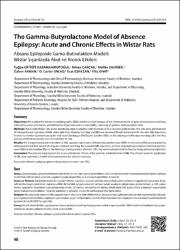The gamma-butyrolactone model of absence epilepsy: Acute and chronic effects in wistar rats

Göster/
Erişim
info:eu-repo/semantics/openAccessTarih
2013Yazar
Karamahmutoğlu, Tuğba EryiğitÇarçak, Nihan
Şahiner, Melike
Akman, Özlem
Snead, O. Carter
Eşkazan, Esat
Onat, Filiz
Üst veri
Tüm öğe kaydını gösterKünye
Karamahmutoglu TE, Carcak N, Sahiner M, Akman O, Snead OC, Eskazan E, Onat F. The gamma-butyrolactone model of absence epilepsy: Acute and chronic effects in wistar rats. Türk Epilepsi İle Savas Dernegi. 2013; 19(2): 48-52.Özet
Introduction A pharmacological modeling approach to absence epilepsy requires a reproducible and predictable method that has the EEG and behavioral characteristics of generalized typical absence seizures in humans. The gamma-hydroxybutyrate (GHB) and gamma-butryrolactone (GBL) models meets these criteria.[1,2] The acute administration of GBL, which is a prodrug of GHB, has been shown to produce exactly the same EEG and behavioral effects of absence seizures as GHB [3] and GBL administration mimics typical absence epilepsy in humans.[4] GBL is preferred due to the consistency, predictable dose response and rapidity of the onset of its action in rodents.[5-7] The systemic administration of a single dose of GBL produces absence seizures through the potentiation of the GHB-related neuromodulation and/or interaction with GABAergic inhibitory and excitatory neurotransmission in the cortico-thalamo-cortical circuit. The objective of this study was to determine the EEG and behavioral changes induced by acute and chronic administration of GBL in male adult Wistar rats

















